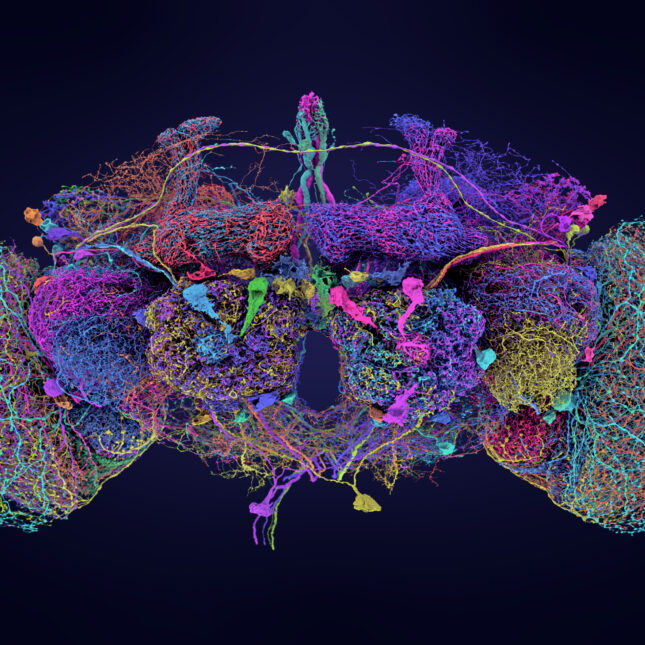
Mapping the brain is a daunting task because it contains a huge number of cells and cell connections. It took almost 50 labs around the world to create a new neural map, or connectome, of an adult fruit fly — the largest map of its kind, and an effort that will allow researchers to better understand the brain’s inner workings.
Access to the full connectome, as published Wednesday in a series of papers in Nature, could represent a new era for neuroscience, according to some researchers. John Ngai, director of the National Institutes of Health’s BRAIN initiative, told STAT he was “blown away by the depth of detail of what it can tell us about how neurocircuits work, in a way that was aspirational 10 years ago when we started this whole thing.”
The papers also expand the boundaries of what neuroscientists are capable of, experts say, in harnessing powerful AI algorithms to handle massive amounts of data and tapping so many collaborators for a single project. The connectome catalogues more than 50 million connections between more than 130,000 cells, offering information that will help researchers explore how the brain processes information and performs certain tasks, as well as what goes awry in various diseases.
“You can’t fully understand animals’ behaviors without understanding how the brain is wired up. That’s just a fundamental prerequisite,” said Michael Winding, a systems neuroscientist at the Francis Crick Institute who helped create a connectome of a fly larva, but was not involved with the new Nature papers.
The completion of the fly connectome represents the latest discovery in a steady march of advancements in connectomes. The first neural map was created almost four decades ago, of the brain of a nematode, but in the past year alone, researchers have created connectomes of a fly larva, a connectome of a small part of a mouse brain, and even a connectome of a cubic millimeter of a human brain. “It’s really a renaissance,” Winding said.
The maps were created by slicing a fly brain into chunks thinner than a ray of light, taking images of those slices, and reverse-engineering an atlas of the brain from those pictures in three dimensions.
Some of the first connectomes were created by hand, with scientists tracing the connections between neurons. But AI algorithms have made it possible for neuroscientists to dream bigger. Instead of trying to piece together the puzzle of the fly brain by hand, AI algorithms do the majority of the work, with researchers going in to proofread and correct the model when the AI is wrong. The researchers estimate that the adult fly connectome would have taken a single person 33 years to complete solo — and thousands of years without the help of the AI tools.
At a press conference discussing the new papers, Sebastian Seung, a computational biologist at Princeton University who was part of the research team, echoed a colleague’s quip that “the history of neuroscience can now be divided into two eras, BC and AC” — before and after connectome.
Alongside the Nature paper documenting the complete connectome, researchers discuss some of the questions that may be answered with such a dataset, such as how flies walk around and come to a stop, how flies groom themselves, and how different neurons work together to help flies see the world. Winding has also been using the larva connectome to understand how larvae socialize and can even work together.
Neuroscientists are also working to scale the technology up to understand larger and more complex brains. The next big target is the mouse brain, the most common mammal used in neuroscience research, which would bring researchers one step closer to the eventual goal of creating a human connectome. But currently “it is not technically feasible to do,” said Forrest Collman, a neuroscientist at the Allen Institute and one of the paper’s co-authors. “There are a number of projects and technological developments that are trying to improve the scale of imaging that is possible,” he said, and to make the reconstruction algorithms more cost-effective.
While several researchers expressed hope that a mouse connectome could become a reality in the next decade, a human connectome is likely much further away. The techniques and technology researchers currently use wouldn’t be up to the task. And the data required to store a complete human connectome would be in the neighborhood of a zettabyte — roughly equivalent to all of the data used on the internet in a year.
Creating connectomes of different areas of the human brain may be a more realistic goal. In the meantime, the fruit fly could have plenty of lessons for researchers, particularly when it comes to treating diseases affecting neural circuits like Alzheimer’s or Parkinson’s.
The connectome is “a critical piece in this larger continuum of research that is going to be necessary not just to treat the symptoms of disease, but hopefully one day, to cure them,” Ngai said. “Because you can’t fix what you don’t understand, and having these connectomes is going to be key for understanding what is really tantamount to circuit disorders.”






